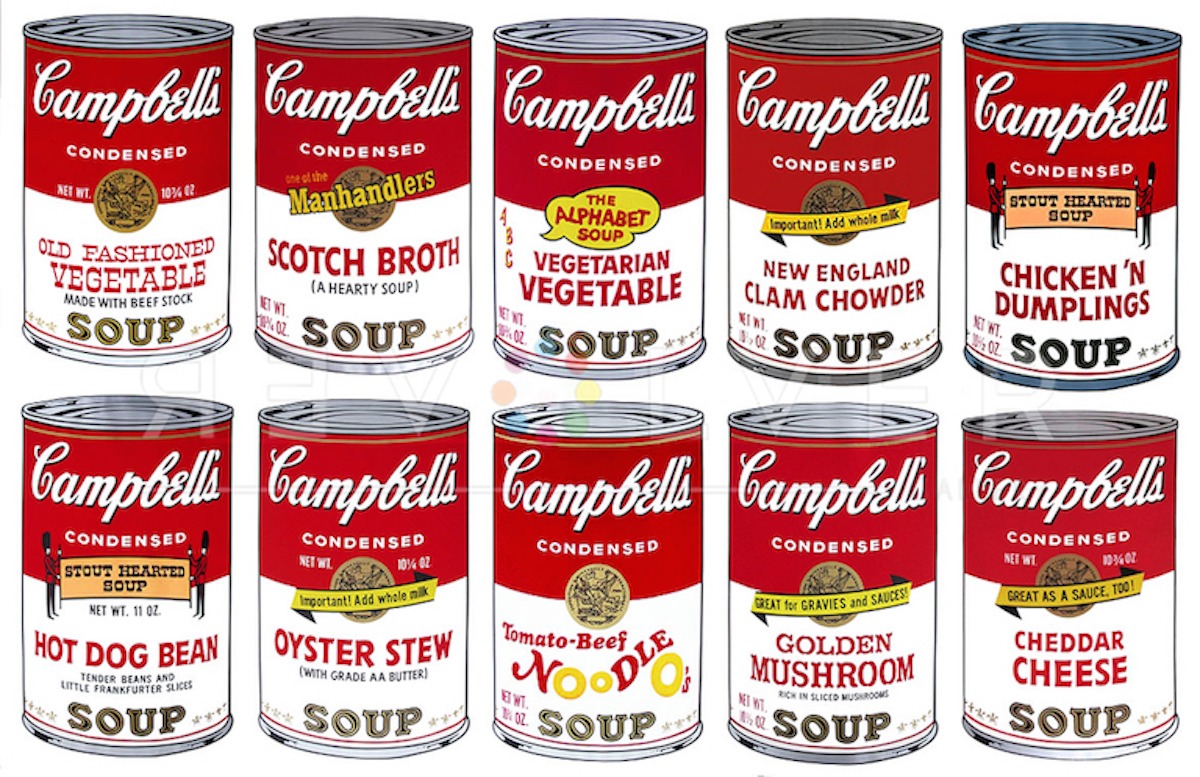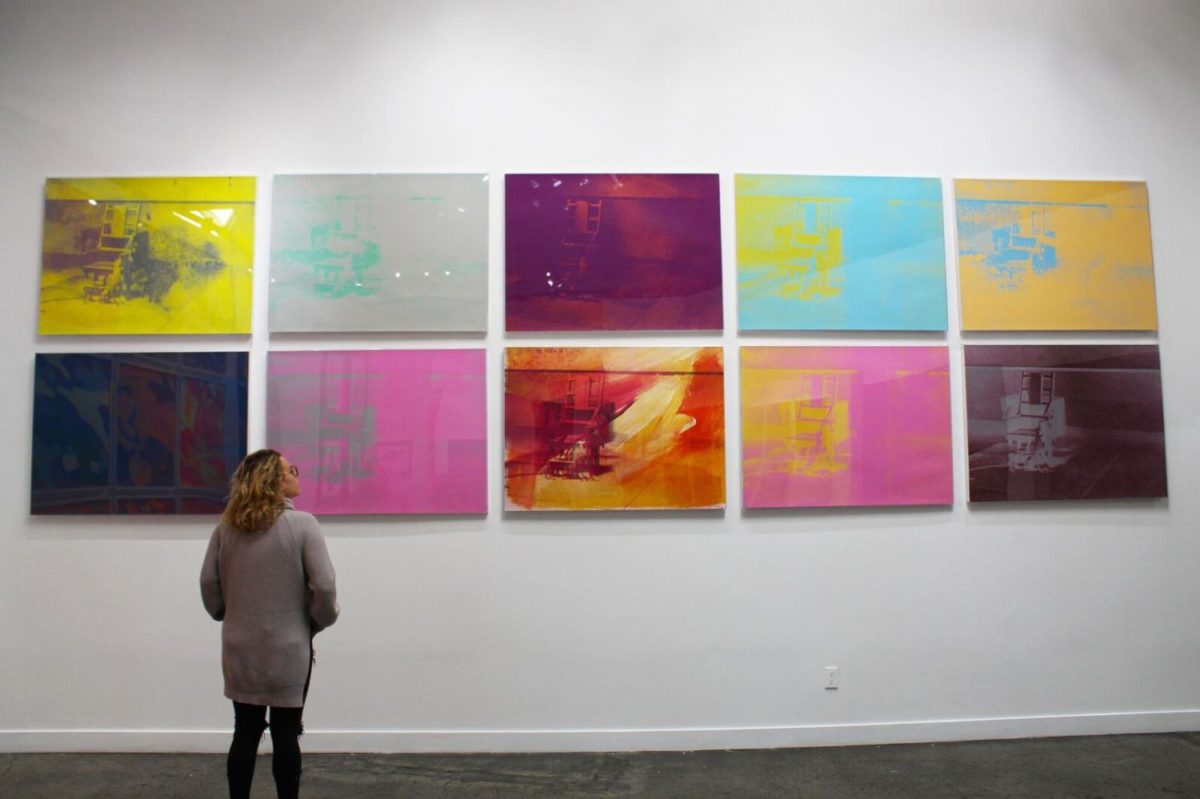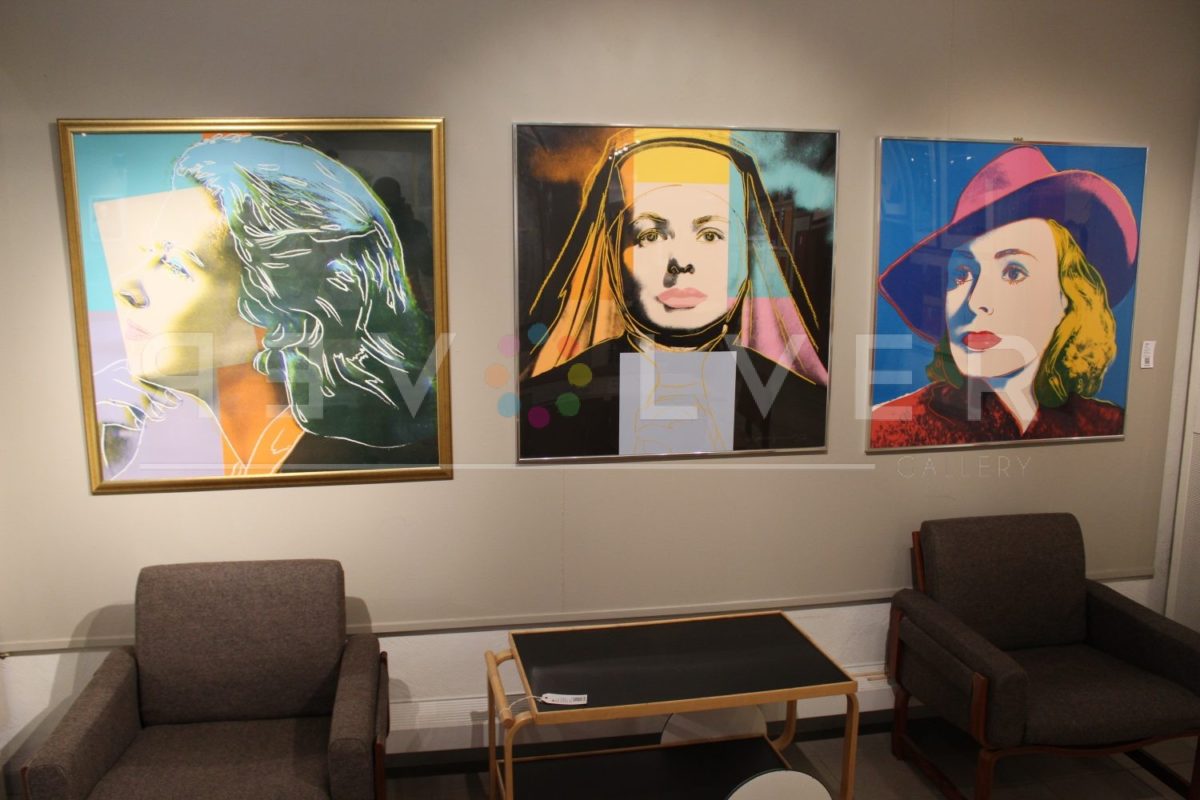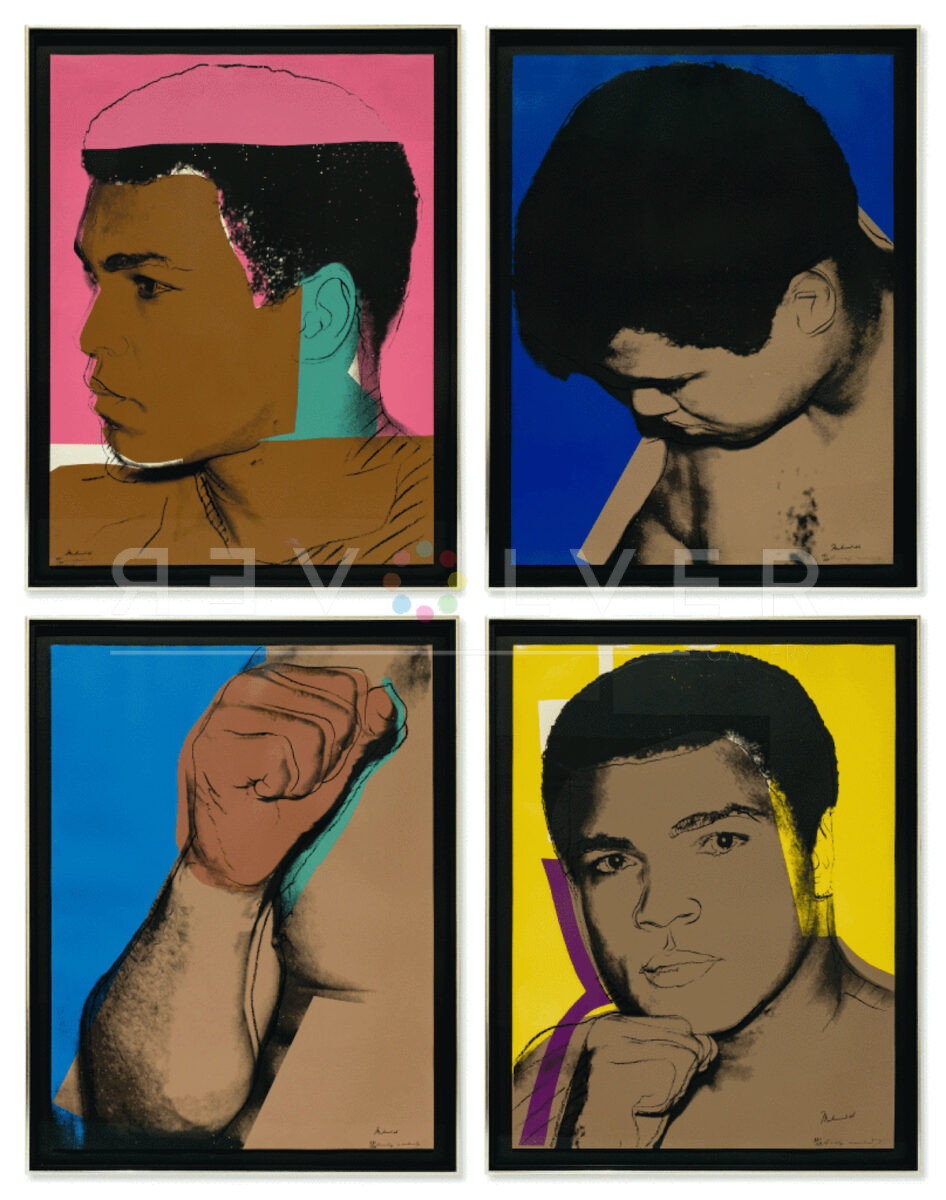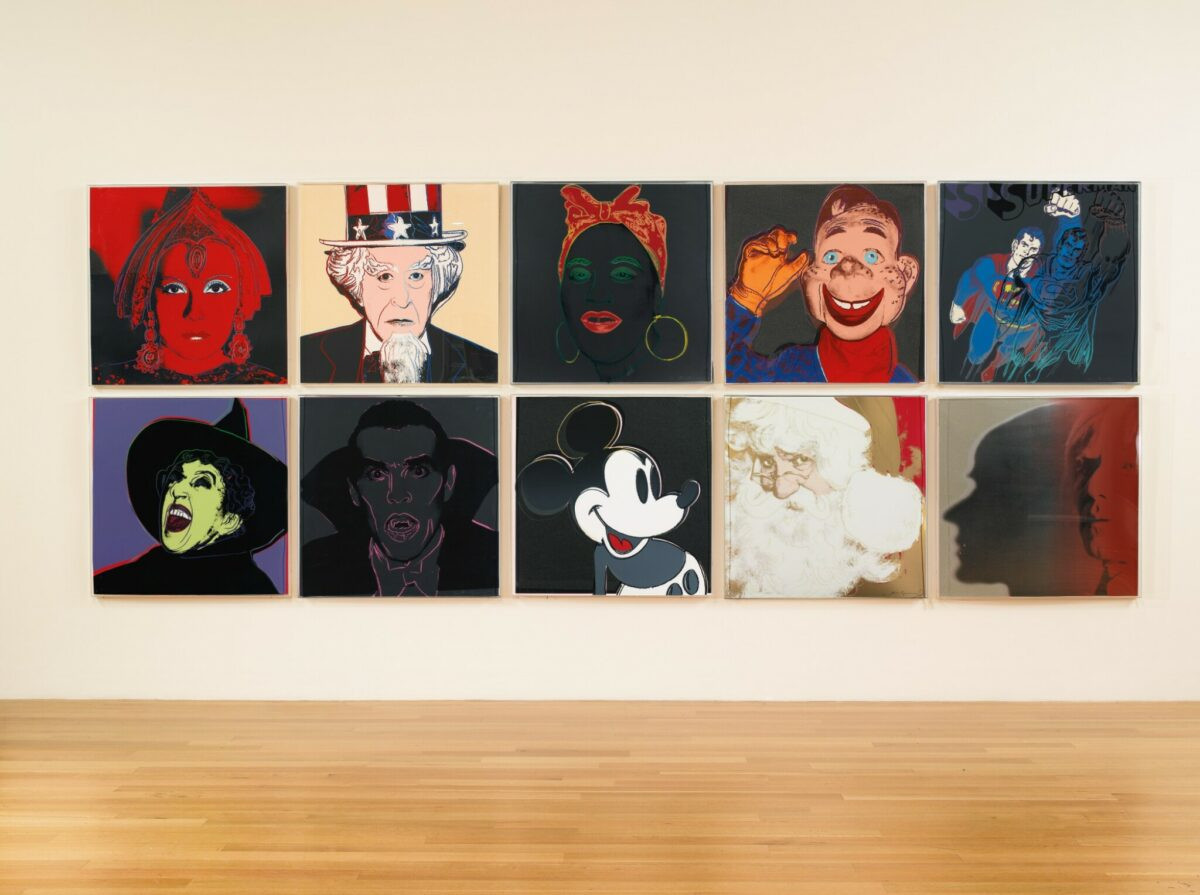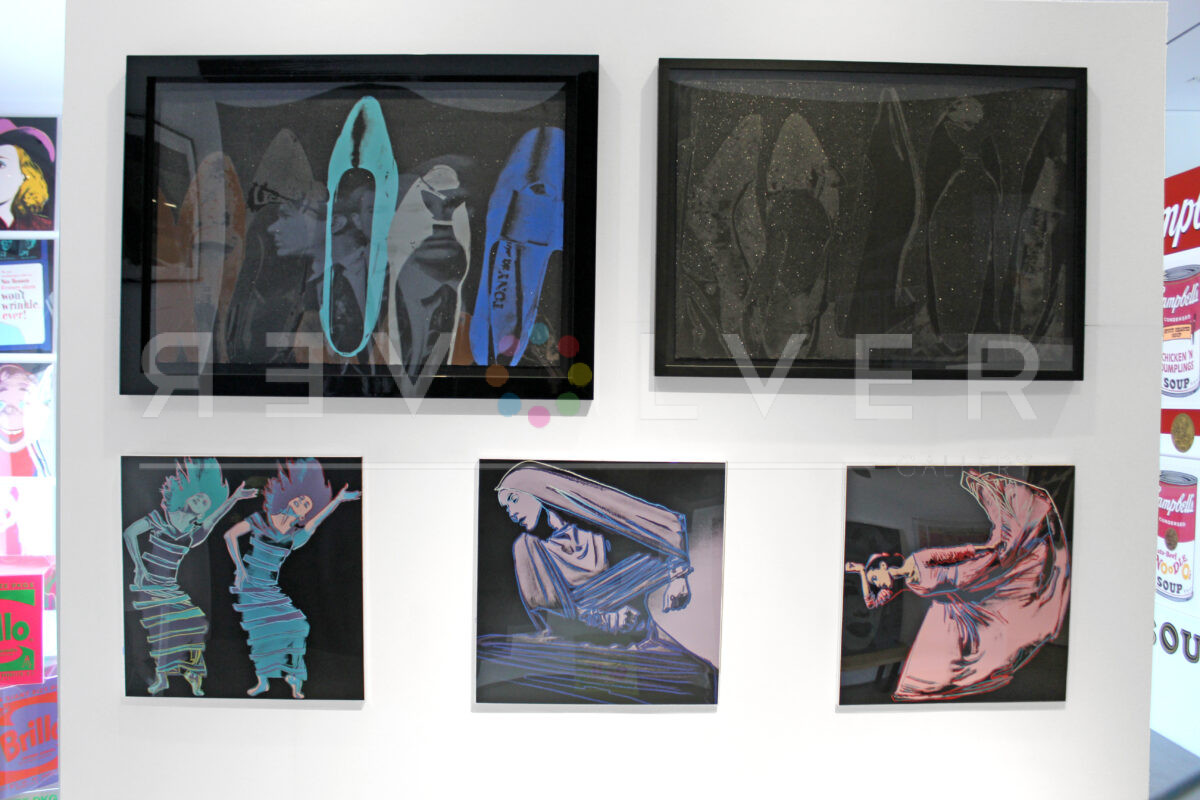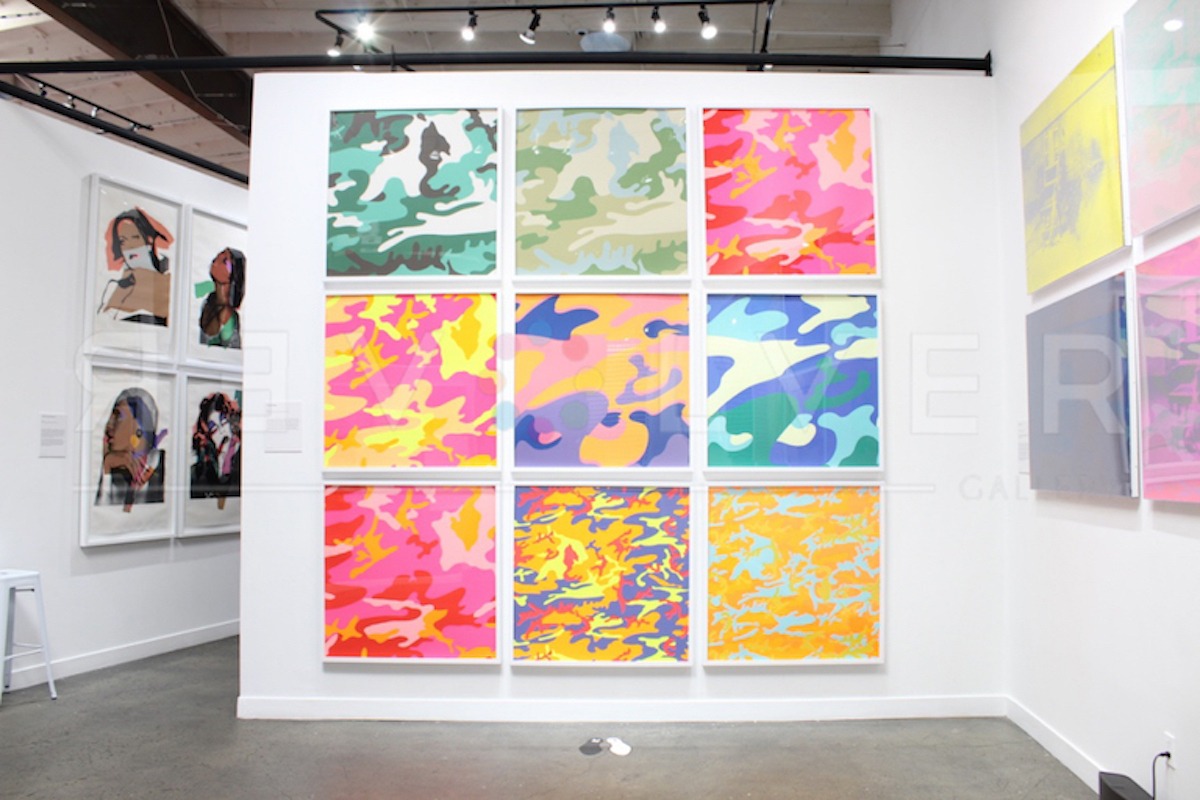Many have described Andy Warhol as a “mirror of his age,” capturing the essence of his time and reflecting it back to the world through his artworks. This is perhaps most apparent when examining the content of his published portfolios. To fully appreciate the significance of Warhol’s portfolios and their investment potential, one should look at the trajectory of his career, his evolving methods, and the deep-seated fascinations that animated his practices and artistic output.
Warhol published his first editioned print in 1962, called Cooking Pot. It resembled an advertisement, depicting a common household good. In the following years, prints of various subject material followed: from the Birmingham Race Riot to Liz Taylor and images of Campbell’s Soup cans printed on shopping bags. It wasn’t until 1966, however, that his shift into printmaking began to truly take shape and transform his career. By that time, his painting sales were dwindling and many artists were exploring prints as a new avenue for income. In 1966, Warhol ventured into the first project that resembled the portfolios he would come to specialize in: three prints of Jackie Kennedy, based on publicity photographs from Life Magazine. These works were part of the “11 Pop Artists I” portfolio, published by Original Editions in New York City, which also featured pieces by renowned artists like Roy Lichtenstein, Allen Jones, and James Rosenquist. Though the works were published separately, unlike portfolios, the Jackie series of artworks represents the first inkling of Warhol’s movement towards organizing his artworks into such groups.
In 1967, Warhol took a decisive step by establishing Factory Additions, his in-house publishing enterprise. This venture marked a new phase in his career, beginning with a suite of ten varied color scheme screenprints of Marilyn Monroe, a portfolio that revisited and reimagined some of the most iconic paintings from his early career. This shift was not just a change in medium but a strategic move that intertwined art with business. With the Marilyn portfolio, Warhol presented 10 striking prints all at once, to be bought, sold, and displayed together.
The initial success of the Marilyn Monroe portfolio set a precedent, leading to the creation of other renowned series such as Campbell’s Soup I and II, and Flowers, all published by Factory Additions. Each portfolio was a meticulous and deliberate endeavor, showcasing Warhol’s deep engagement with the medium of screenprinting. In this process, screenprinting served dual purposes: it was both the means of creation and an integral part of the message conveyed by his art.
Both strategic and philosophical considerations drove Warhol’s decision to publish artworks in portfolios. Strategically, portfolios allowed Warhol to showcase the breadth of his creativity, presenting a series of works that could be appreciated individually yet gained greater depth when viewed together. Philosophically, these portfolios embodied Warhol’s fascination with mass production and his desire to blur the lines between high art and commercial art. By producing artworks in editions, Warhol democratized his art, making it accessible to a wider audience and challenging traditional notions of art’s exclusivity.
Warhol’s approach to conceiving a complete portfolio was as varied as his subjects. Each portfolio began with a central idea, inspiration, or commission, from which Warhol expanded, adding artworks that offered different perspectives or interpretations. This method allowed for a dynamic exploration of themes, from celebrity culture and consumerism to political commentary, art history, and personal introspection. Sometimes Warhol would take his own photographs of subjects, using them as source material for his portfolios rather than readymade images or portraits. For example, In portfolios like Mick Jagger and Ladies and Gentlemen, Warhol knew he wanted to create compilations of various portraits, and photographed his subjects accordingly.
Warhol’s portfolios are cultural milestones. For collectors, acquiring a complete Warhol portfolio means embracing this complex interplay of artistic appreciation, democratization, seriality, and the vicissitudes of mechanical reproduction. Yet the variation within each portfolio is also a hallmark of Warhol’s ingenuity. He played with color, composition, and scale, ensuring that each print, while part of a larger collection, stood on its own as a unique piece of art. This paradox of diversity within unity is what makes Warhol’s portfolios so captivating and enduring.
Each of Warhol’s portfolios is akin to a unified work of art, coalescing into a narrative that offers insights into Warhol’s creative process and interests. Beyond the exploration of images, Warhol wove stories imbued with ideas, subtly resonating with the worldview of his era. In their layered complexity, these grouped artworks reflect a dialogue with the broader cultural and theoretical discourses of the time. Thus, to own a complete Warhol portfolio is to hold a segment of art history – a series of prints that collectively embody the full breadth of Warhol’s artistic vision and narrative.
8 of our Complete Portfolios for Sale at Revolver Gallery
At Revolver, we are always acquiring more Andy Warhol artworks. Today, we have more than 20 complete portfolios in our collection, ranging from the beginning to the end of his prolific career. Each authenticated work in these sets is an important fragment of the artist’s identity and an integral piece of his exploration of eclectic themes.
Let’s take a closer look at 8 different portfolios currently for sale at Revolver. Investigating these complete portfolios allows for a deeper appreciation of their significance in the grander context of Warhol’s oeuvre. At Revolver, Warhol’s legacy is alive on every wall, tangibly captured in larger-than-life prints and poised to become an effervescent reminder of his artistic genius in a new owner’s home.
1. Campbell’s Soup Cans II
Of all the complete portfolios currently at Revolver, few are more classic than the Campbell’s Soup II portfolio. Made in 1969, this portfolio is the third complete iteration of the Campbell’s soup motif. It began with the monumental 32 Campbell’s Soup Cans paintings that first propelled him to recognition when he unveiled it in 1962. Despite its smaller quantity, the Campbell’s Soups II portfolio maximizes its Warholian qualities tenfold, being mass-produced in an edition of 250. It is further distinguished by Warhol’s addition of cheeky catchphrases and whimsical lettering, infusing the nostalgic set with his Pop Art tastes. Campbell’s Soup II is also a prime example of Warhol’s vision for the democratization of art. Not only is the portfolio a thematic repeat of his earlier Campbell’s works, which showcases his understanding of serialization as an act of creating accessibility, but it also portrays a common can of soup as a piece of art, altering the perception of art to include everyday objects and appealing to the masses. With a simple but clever take on his favorite soup brand, Warhol solidified Campbell’s Soup II as an exemplary token of his interest in consumerism, Americana, and artistic appropriation, making it the perfect portfolio for collectors who want to own something that fully embodies Warhol and the foundation of his iconic career.
2. Electric Chair
Warhol’s Electric Chair portfolio is for those who are captivated by the artist’s ventures into darker, existential themes. This 1971 portfolio is associated with his Death and Disaster series, a commentary on the most morbid aspects of media and American society in a 10-screenprint array. The idea to depict such gruesome imagery was spurred by the rise in media dissemination covering violence, which consequently made tragic events and images more accessible to inform and haunt the masses. Believing in collective desensitization towards violence proportionate to the rise in its media coverage, Warhol created his Death and Disaster series as he watched these cultural values shift. Electric Chair is a piece of this puzzle. Warhol’s first application of the image of the electric chair was with paintings in 1963 when New York performed its last prisoner executions, a subject of popular discourse to this day. When revisiting the concept in 1971, Warhol created dreamlike renditions of the stark imagery which evoke both his signature Pop Art style and the suggestion that weighty subjects are often discussed with a tendency towards abstraction rather than with the gravity of their reality. Through his serialized approach to this portfolio, Warhol also echoed the nature of repetitive imagery in the media and the normalization of violence that produces a detachment from the severity of the subject. It points out that while media dissemination is part of a democratic society, it also has the potential to have the reverse effect and make us complacent and complicit in ignoring tragedy. Electric Chair is one of Warhol’s most continuously relevant portfolios when considering its ability to provoke meaningful dialogue and its reflection of persistent socio-political topics as well as the heightened proliferation of digital media since its creation.
3. Ingrid Bergman
Glamour and fame fascinated Warhol, and this fascination was easily captured in his portraits of celebrities—some of his most celebrated works. One such in-stock at Revolver is his Ingrid Bergman portfolio, a lesser-known gem, but a shimmering specimen of old-Hollywood aesthetics and Warhol’s eye for beauty. Created in 1984, only three years prior to his death, the portfolio is unique for being a later exploration of celebrity than his early career dabbling with Marilyn Monroe and Elvis paintings. By tapping into the cultural interest in celebrities, Warhol made his work interesting to a broader audience. Using this subject matter coupled with his practice of silkscreen printing, Warhol mimicked the repetitious nature of mainstream media and suggested that visual art should be as widely accessible as other forms of art such as music or movies. The Ingrid Bergman portfolio was commissioned by Swedish art gallery Galerie Börjeson, and consists of three silkscreen portraits of the Swedish film darling and Academy Award-winning actress. In Ingrid Bergman, The Nun, and Ingrid Bergman With Hat, Warhol transformed stills from two films that made the actress a household name: “Casablanca” (1942) and “The Bells of St. Mary’s” (1945), into dynamic, Popified images. The third print, Ingrid Bergman, Herself, is similar in style but depicts the starlet in a dignified pose caught by paparazzi. Aesthetically and thematically, Ingrid Bergman oscillates between old and modern, mysterious and bold. By making this portfolio, Warhol immortalized an iconic actress and reminded viewers of his reign as the master of contemporary portraiture.
4. Muhammad Ali
While the Ingrid Bergman portfolio offers a glimpse into Warhol’s enchantment with cinema magic, his 1978 Muhammad Ali portfolio in stock at Revolver Gallery showcases another kind of star: the celebrity athlete. Comprising four screenprints that depict three-time heavyweight boxing champion and activist Muhammad “The Greatest” Ali, this portfolio is an offshoot of Warhol’s Athletes series of paintings, which placed 10 different star athletes on a Pop-Art pedestal. The Ali portfolio housed in Revolver Gallery is double-signed by Muhammad Ali and Andy Warhol (of which it is estimated only 16 exist). In creating his Athletes series, Warhol used his cultural clairvoyance to predict the shift in how we perceive athletes that came with the increased accessibility to new forms of media and the rise in televised sports. This new concept of athletes mirroring the idolization of movie stars has only grown truer as time passes, evidenced by the widening spectrum of opportunities available to professional athletes such as lucrative brand deals, movie cameos, and television presenter jobs. Like his movie portraits, portraying a well-known athlete offered a relatable element to Warhol’s work that spoke to the masses. The Muhammad Ali portfolio is an important cultural and artistic artifact portraying both this shift in attitudes towards sports and athletes as well as Warhol’s keen understanding of the zeitgeist.
To create the basis of the screenprints, Warhol photographed the sports hero with his Polaroid camera when he traveled to Ali’s training compound in 1977. Warhol’s eye for detail comes alive in these prints, demonstrated through the series of poses in each image, through which Warhol captures a different aspect of Ali’s essence. One depicts his strong side profile, another showcases his powerful gaze directly at the camera lens, while a third portrays a contemplative chin-down pose. The final print focuses solely on Ali’s hand, a source of wonder for the world, positioned in a striking Orthodox stance. Muhammad Ali pays homage to the many dimensions of the boxer: a lover of peace, a thoughtful advocate for freedom, and a fighter—in the ring for the title of champion, and out of the ring for humankind.
5. Myths
While the Muhammad Ali portfolio sees Warhol exploring a new kind of celebrity, Myths bends our perceptions of celebrity entirely, adding some unlikely (yet familiar) faces to the Warhol canon. It is a portfolio at Revolver that represents folklore, film, and historical pop-culture characters, propelling them to star status. In this 1981 portfolio, Warhol reinvents these icons in neon, technicolor style that makes them glow with the exuberance of the ‘80s. Each of the characters depicted in Myths not only serves as a commentary on the commodification of pop culture and its influence even on children’s media and entertainment, but also reflects aspects of Warhol’s personal history and tastes. The New Spirit (Donald Duck) and Superman wink to his childhood influences while Uncle Sam symbolizes his preoccupations with American themes and capitalism, and so on. Myths is a clever manifestation of Warhol’s practice of artistic appropriation as he adopts familiar imagery as his own creation, altering it slightly to create a complete re-imagining. In this portfolio, however, Warhol takes his sense of irony to a new level by including himself as a character in the series: “The Shadow.” By suggesting that he, himself, is a “mythic” figure, Warhol highlights the potential for anyone to become a myth and the practice of transforming cultural icons into marketable brands. Myths transforms mascots of mass production into figures of high art, and Warhol’s serialized approach to his prints manifests his ideology of separating the distinctions of high and low culture, thereby creating inclusivity in the realm of art. As a full portfolio, Myths is a bold, nostalgic nod to our favorite enigmatic figures and a simultaneous challenge to contemplate the intersection of culture and commerce.
6. Grapes
Although Warhol was a visionary contemporary artist, no one can say that he didn’t have a reverence for the classics. He reinvented Da Vinci’s The Last Supper, Botticelli’s Birth of Venus, and even the timeless tradition of the still-life in his Grapes portfolio, available at Revolver. Made in 1979, the six-screenprint portfolio is a bold, Warholian abstraction of the fruit, portrayed with the color-blocking technique in moody, saturated colors. In Grapes, Warhol’s exploration reveals his desire to revitalize old themes to make them new and aesthetically accessible to the masses. Warhol imbues this portfolio with a sense of movement and plays through his employment of suggestive, dynamic linework and depicting the grapes hanging from vines, creating shadows of themselves. Grapes revisits the theme of Andy Warhol’s collaboration with a French winery, Château Mouton Rothschild, in 1975, during which he designed wine bottle labels. This portfolio draws inspiration from the rich greens, purples, and hues of green utilized four years earlier. In addition, the portfolio’s decadence is heightened with a special edition with diamond dust. The recipe of finely crushed glass, invented by Warhol’s Master Printer Rupert Jasen Smith, produces a mesmeric, glimmering effect that reflects Warhol’s grandeur. Grapes pays homage not only to his love of the classics but also his appreciation for the finer things in life, making it a beautiful potential addition for anyone who loves good wine.
7. Martha Graham
Warhol valued other art forms as much as he did his own, using film, music, and others as inspiration for his works. This multidisciplinary approach is showcased in eye-popping neon hues in his three-screenprint portfolio that centers on the founder of a lauded American contemporary dance studio and the mother of modern dance, Martha Graham. This 1986 portfolio was created to mark the sixteenth anniversary of her life’s work, The Martha Graham Dance Center of Contemporary Dance. In her field, Graham was a visionary choreographer who sought to capture raw humanity in her dance. Her new technique elevated dance to a form of social and political inquiry, mirroring societal complexities and challenging the norms through her subject matter and style. For her accomplishments and outstanding contribution to society, Graham was honored with the highest civilian distinction, the Presidential Medal of Freedom, in addition to many other accolades. Warhol’s portfolio portrays Graham’s powerful essence, full of life and dynamism imbued through emotional expressions, fluid lines, and grand dance poses; each of the three screenprints is titled and designed to commemorate one of Graham’s most well-known dances. In Martha Graham, Warhol bridges the gap between the transcendent nature of Graham’s accomplishments and her mainstream fame and notoriety, marking the portfolio with his democratic art philosophy. Warhol’s years-long friendship with Graham often found him in the audience at the dance legend’s performances, making this portfolio all the more personal to him. Like Graham herself, The Martha Graham Complete Portfolio is a national treasure that speaks to making art from the heart. No doubt, it would be a meaningful investment for collectors who are artistic connoisseurs, and who wish to own a piece of the legacy that forged a revolutionary style of movement and transformed dance into a fierce mechanism for social and political advocacy.
8. Camouflage
If any portfolio embodies Warhol’s ability to manipulate the cultural pulse, it’s his Camouflage portfolio, also housed at Revolver. Camouflage, made in 1987, is one of the last portfolios that Warhol created and was left unsigned due to his untimely death before they were published. Like many other works, they are signed by the Executor of the Andy Warhol Estate, Fred Hughes, and stamped with a certificate of authenticity. The idea for the eight-screenprint portfolio came about when Warhol witnessed his art assistant Jay Shriver creating abstract paintings by pushing paint through a camouflage-covered mesh military fabric. Warhol purchased more camo fabric at the army surplus store to create an outline for what would become vivid, eye-catching versions of the pattern. The colorful opposition to the neutral military clothing in Camouflage was at the forefront of the counterintuitive transformation of camouflage patterns: from a disguisable uniform into a loud Pop Art fashion statement. Indeed, Warhol created Camouflage before it meant anything other than a common military pattern. Perpetuating the trend, Warhol also collaborated with fashion designer Stephen Sprouse to create a camo-pop line. Warhol also used the camo motif in 1986 for some of his most notable self-portraits (Camouflage Self-Portait, 1986) as well as Joseph Beuys In Memorium, a 1986 portrait of the artist and activist. He even used a camouflage pattern to shroud something as globally recognized as the Statue of Liberty in one series of paintings.
In his experiments with camouflage (especially his self-portraits), Warhol’s layering of images with camo patterns evokes themes of perception and selfhood. The contrast between presenting notable figures and portraying them under a pattern intended to mask visibility is suggestive of a critical understanding of identity. The artist’s use of camouflage highlights the parts of one’s identity that remain hidden, even for the most famous of faces, and challenges the idea that anyone can truly be known completely. After all, this was a concept very familiar to Warhol, especially due to the paradox of his fame, his constant proximity to celebrities, and his seemingly impossible simultaneous masking of his own identity. A unique recontextualization of a traditional symbol, Camouflage is a testament to Warhol’s innovative approach, his sensitivity to trends, and his insight into the complexities of human nature. For a collector, the distinct circumstances around the inception of Camouflage increase the portfolio’s exclusivity and enhance its significance among Warhol’s oeuvre.
These 8 portfolios are only a small piece of the Andy Warhol artworks housed by Revolver. Overall, Warhol’s portfolios intrigue serious collectors with their historical significance, the opportunity to engage with Warhol’s vision in its totality, and their lucrative investment potential. A portfolio represents a complete chapter in Warhol’s artistic journey, providing a comprehensive piece of the depth of his work and the themes of an era he sought to capture. Indeed, for many collectors, owning one of Warhol’s portfolios, complete with matching edition numbers, isn’t just a smart investment—it’s one of the most prestigious achievements in the art world.
In essence, Andy Warhol’s complete portfolios are more than just suites of prints; they are cultural artifacts that capture a slice of the zeitgeist of an era and a specific moment in the artist’s life and career. They stand as a testament to Warhol’s genius in bridging the gap between historical reverence and contemporary art. For collectors and art enthusiasts alike, these portfolios offer an unparalleled opportunity to delve into the heart of Pop Art, exploring its themes, its evolution, and its enduring impact on the art world.
Do you own a complete portfolio by Andy Warhol? For many, a Warhol portfolio might be the perfect next step to elevate one’s art collection. For a comprehensive view of Warhol’s portfolios, click here.


